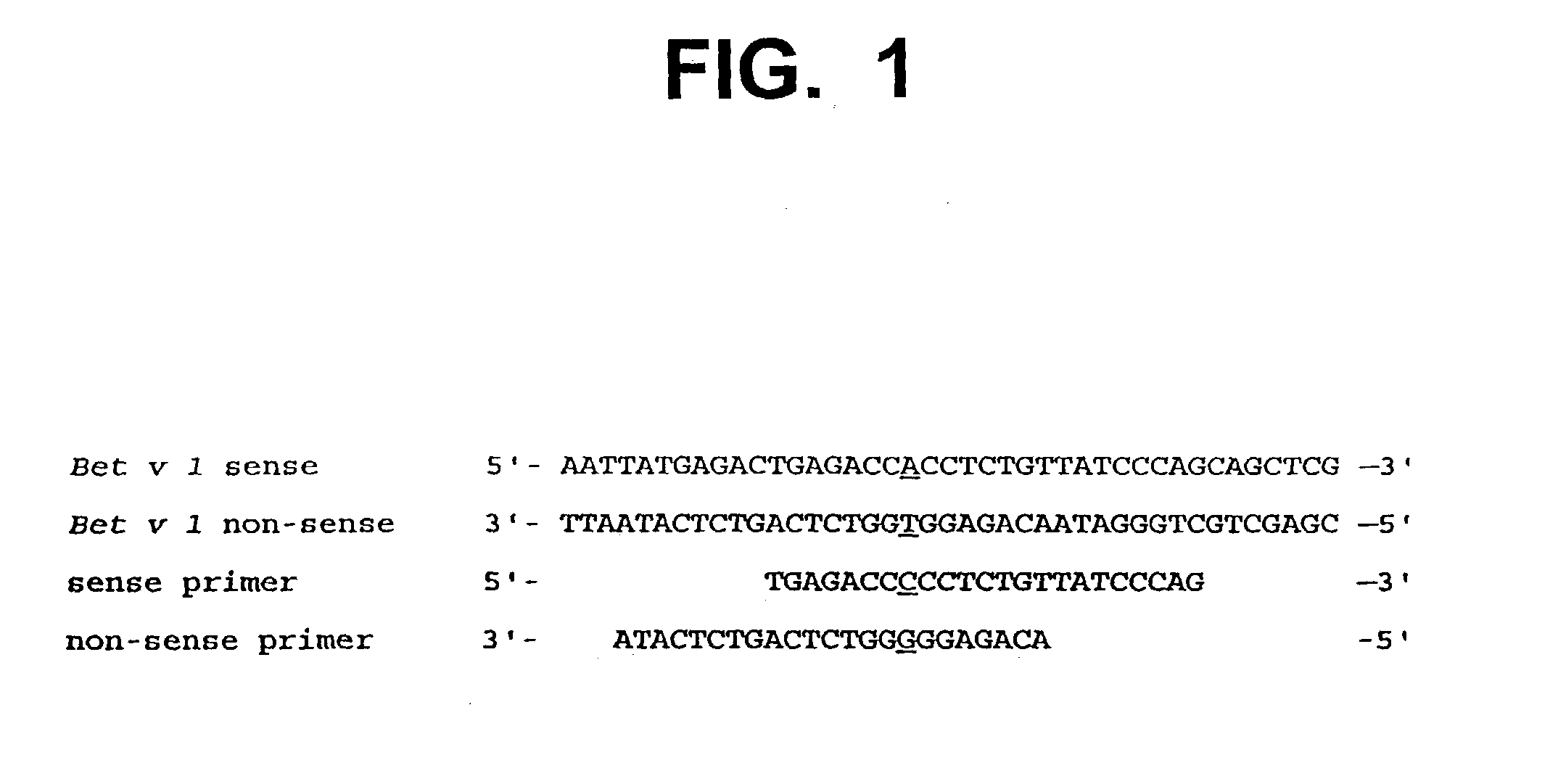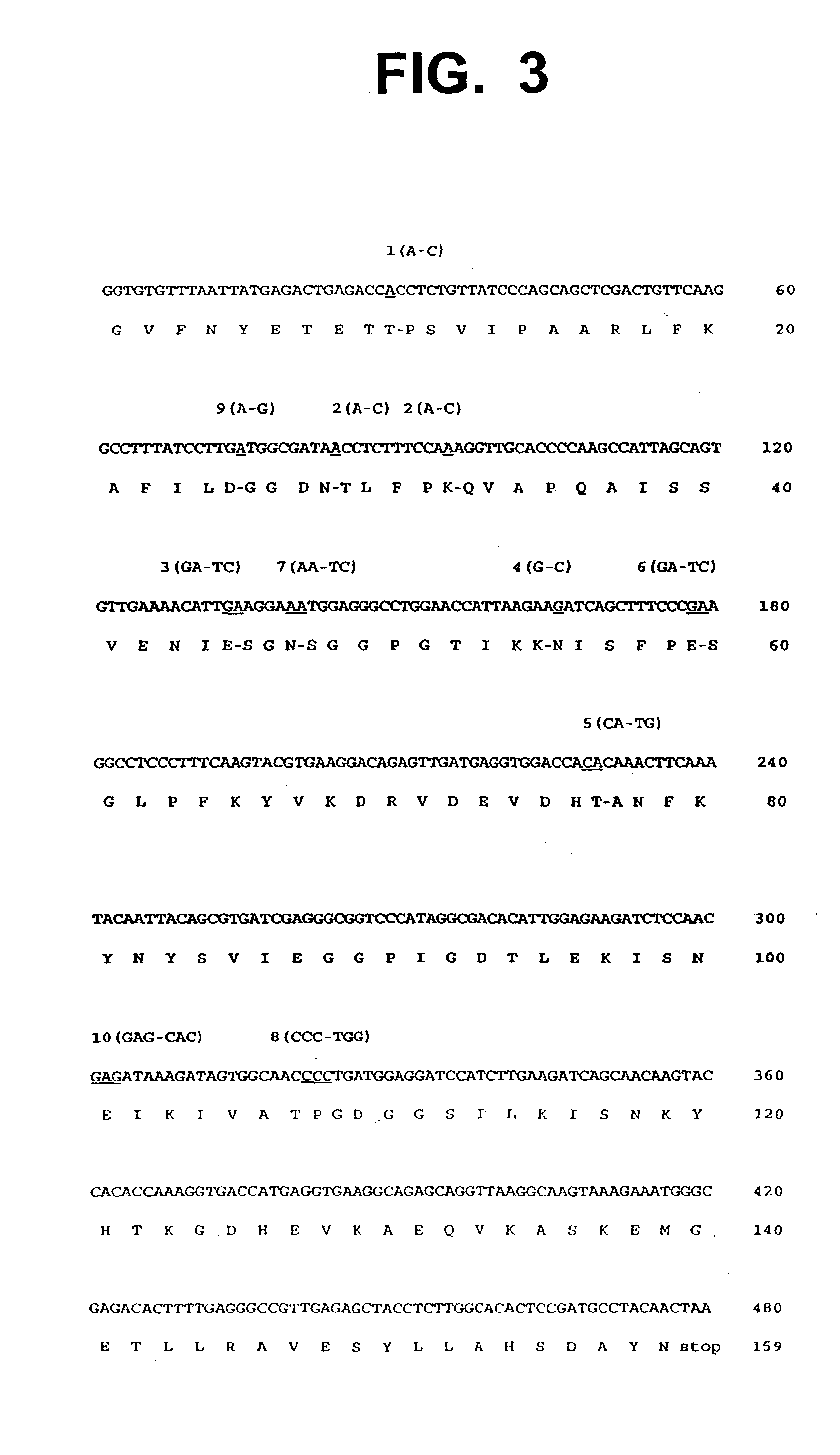Novel mutant allergens
a technology of allergens and mutants, applied in the field of new mutant allergens, can solve the problems of significant pathological states, life-threatening, and subsequent exposure may provoke symptoms, and achieve the effects of reducing allergen-mediated cross-linking, raising igg response, and improving protection
- Summary
- Abstract
- Description
- Claims
- Application Information
AI Technical Summary
Benefits of technology
Problems solved by technology
Method used
Image
Examples
example 1
[0212] Example 1 describes the preparation of recombinant mutant allergens with one and three primary mutations. Recombinant mutant allergens according to the invention, i.e. allergens comprising at least four primary mutations, may be prepared using the same procedures.
[0213] Identification of Common Epitopes within Fagales Pollen Allergens
[0214] The major birch pollen allergen Bet v 1 shows about 90% amino acid sequence identity with major allergens from pollens of taxonomically related trees, i.e Fagales (for instance hazel and hornbeam) and birch pollen allergic patients often show clinical symptoms of allergic cross-reactivity towards these Bet v 1 homologous proteins.
[0215] Bet v 1 also shows about 50-60% sequence identity with allergic proteins present in certain fruits (for instance apple and cherry) and vegetables (for instance celery and carrot) and there are clinical evidence for allergic cross-reactivity between Bet v 1 and these food related proteins.
[0216] In addition,...
example 2
[0291] Example 2 describes the preparation of recombinant mutant allergens with one primary mutation. Recombinant mutant allergens according to the invention, i.e. allergens comprising at least four primary mutations, may be prepared using the same procedures.
[0292] Identification of Common Epitopes Within Vespula vulgaris Venom Major Allergen Antigen 5
[0293] Antigen 5 is one of the three vespid venom proteins, which are known allergens in man. The vespids include hornets, yellow-jacket and wasps. The other two known allergens of vespid venoms are phospholipase A.sub.1 and hyaluronidase. Antigen 5 from Vespula vulgaris (Ves v 5) has been cloned and expressed as recombinant protein in the yeast system (Monsalve et al. 1999, ref. 22). The three-dimensional crystal structure of recombinant Ves v 5 has recently been determined at 1.8 .ANG. resolution (in preparation) . The main features of the structure consist of four .beta.-strands and four .alpha.-helices arranged in three stacked la...
example 3
[0342] Identification and Selection of Amino Acids for Substitution
[0343] The parameters of solvent accessibility and conservation degree were used to identify and select surface-exposed amino acids suitable for substitution for the allergens Bet v 1, Der p 2 and Ves v 5.
[0344] Solvent Accessibility
[0345] Solvent accessibility was calculated using the software InsightII, version 97.0 (MSI) and a probe radius of 1.4 .ANG. (Connolly surface).
[0346] Internal cavities were excluded from the analyses by filling with probes using the software PASS (Putative Active Sites with Spheres) . Probes on the surface were subsequently removed manually.
[0347] Conservation
[0348] Bet v 1:
[0349] 3-D structure is based on accession number Z80104 (1bv1.pdb).
[0350] 38 other Bet v 1 sequences included in the analysis of conserved residues comprise accession numbers: P15494=X15877=Z80106, Z80101, AJ002107, Z72429, AJ002108, Z80105, Z80100, Z80103, AJ001555, Z80102, AJ002110, Z72436, P43183=X77271, Z72430, A...
PUM
| Property | Measurement | Unit |
|---|---|---|
| area | aaaaa | aaaaa |
| radius | aaaaa | aaaaa |
| surface area | aaaaa | aaaaa |
Abstract
Description
Claims
Application Information
 Login to View More
Login to View More - R&D
- Intellectual Property
- Life Sciences
- Materials
- Tech Scout
- Unparalleled Data Quality
- Higher Quality Content
- 60% Fewer Hallucinations
Browse by: Latest US Patents, China's latest patents, Technical Efficacy Thesaurus, Application Domain, Technology Topic, Popular Technical Reports.
© 2025 PatSnap. All rights reserved.Legal|Privacy policy|Modern Slavery Act Transparency Statement|Sitemap|About US| Contact US: help@patsnap.com



